1. Structure Seismology
1.1 Mantle Structure Based on Full Waveform Inversion
Mapping seismic structures for the Earth’s mantle is critical to understand its physical properties and convecting mechanisms. In comparison to classical ray-based travel time tomography, full waveform inversion (FWI) enables us to better extract quantitative information on the Earth’s materials by fitting recorded seismograms with full-wavefield modeling results. Recent advances in high-performance computing and high-quality, three-component seismic records make 3-D FWI feasible at both continental and reservoir scales. We have successfully developed several continental-scale multi-parameter FWI models for North America, Antarctica, Australia and Europe. From these models, we are able to better characterize seismic structures for the lithosphere, asthenosphere, transition zone and subduction zones underneath these regions. Our models also include 3-D variations in attenuation and anisotropy, which enable us to better convert seismic parameters to physical quantities of the Earth’s mantle.
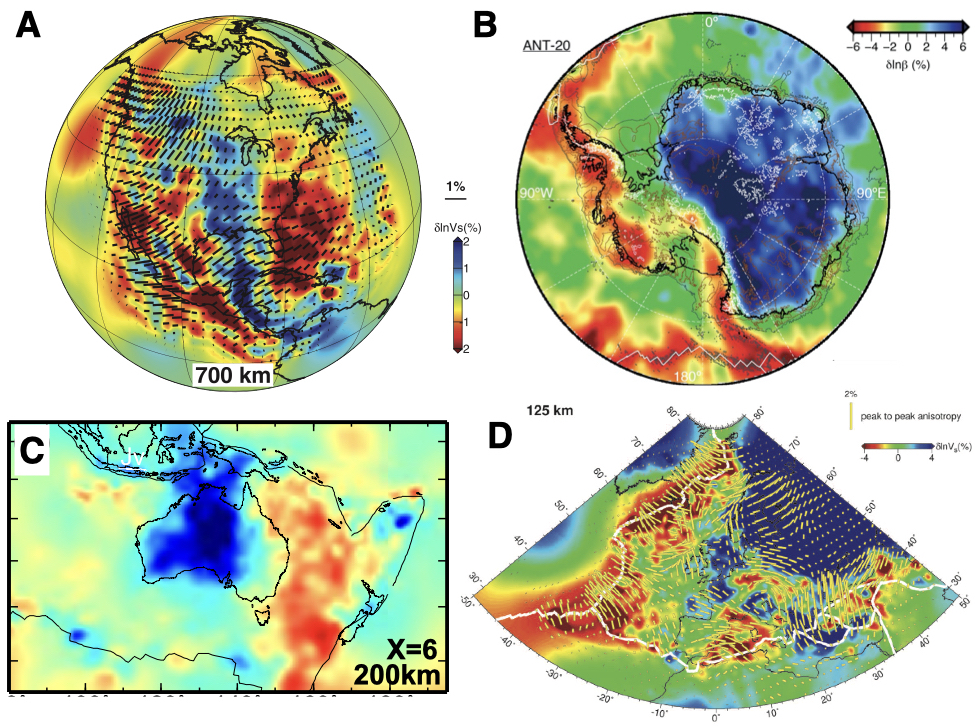
Key publications related to this direction:
(1) H. Zhu, E. Bozdag, D. Peter and J. Tromp, 2012, Structure of the European upper mantle revealed by adjoint tomog- raphy, Nature Geoscience, 5, 493–498.
(2) H. Zhu, E. Bozdag and J. Tromp, 2015, Seismic structure of the European crust and upper mantle based on adjoint tomography, Geophysical Journal International, 201, 18–52.
(3) H. Zhu, D. Komatitsch and J. Tromp, 2017, Radial anisotropy of the North American upper mantle based on adjoint tomography with USArray, Geophysical Journal International, 211, 349–377.
(4) A. Lloyd, D. Wiens, H. Zhu, J. Tromp, A. Nyblade, R. Aster, S. Hansen, I. Dalziel and T. Wilson, 2020, Radial anisotropic seismic structure of the Antarctic upper mantle based on adjoint tomography, Journal of Geophysical Research- Solid Earth, 125, e2019JB017823.
(5) X. Li and H. Zhu, 2020, Radially anisotropic upper mantle structures beneath the Australian plate using full-waveform inversion, submitted to Journal of Geophysical Research-Solid Earth.
1.2 Subduction-induced mantle flows
The recycling of oceanic lithospheres back into the Earth’s mantle provides major driving forces for plate tectonics and represents one of the most important processes taking place in our planet. Understanding how slabs sink from the surface to the deep Earth and how they interact with the ambient mantle is crucial for understanding the dynamic processes in our planet. However, to date, some key questions associated with subduction geo-dynamics remain unresolved, in particular, the pattern of mantle flow and deformation around the descending slabs is still poorly understood. The UTD Seismic Imaging Laboratory has successfully developed an FWI algorithm to constrain 3-D variations in seismic anisotropy, which has been applied to delineate the morphology of subducting slabs and induced mantle flows for the Middle American, Caribbean and Cascadian Subduction Zones. In these results, we observe strong toroidal-mode mantle flows wrapping around the descending slabs. In addition, we observe mantle flows moving through windows among different slabs, which might be produced by large pressure gradients generated by the segmentation of slabs. Our results are the first comprehensive seismic study to directly image depth-distributed mantle flow fields in actual subduction environments using the advanced FWI technology.
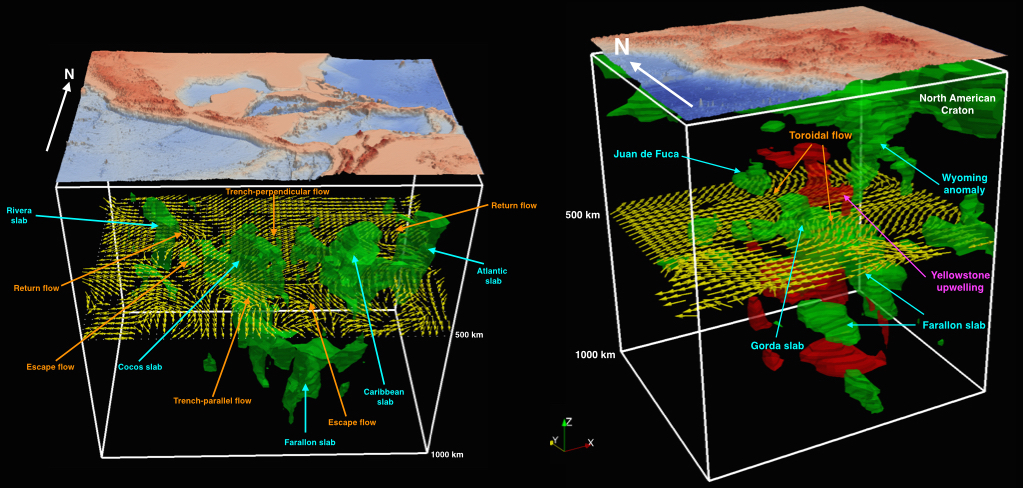
Key publications related to this direction:
(1) H. Zhu and J. Tromp, 2013, Mapping tectonic deformation in the crust and upper mantle beneath Europe and the North Atlantic Ocean, Science, 341, 871–875.
(2) H. Zhu, J. Yang and X. Li, 2020, Azimuthal anisotropy of the North American upper mantle based on adjoint tomog- raphy with USArray, Journal of Geophysical Research-Solid Earth, 125, e2019JB018432.
(3) H. Zhu, X. Li, J. Yang, R. Stern and D. Lumley, 2020, Poloidal- and toroidal-mode mantle flows underneath the Cascadia subduction zone, Geophysical Research Letters, 47, e2020GL087430.
(4) H. Zhu, R. Stern and J. Yang, 2020, Seismic evidence for subduction-induced mantle flows underneath Middle America, Nature Communications, 11, 1–12.
1.3 Crustal Velocity Models for the State of Texas and Oklahoma
Since 2000, ambient noise tomography has been widely utilized to investigate crust and mantle structures. This approach uses coherent noise to extract Green’s functions between a pair of stations. Such noise might come from a wide range of sources, such as waves and winds from the oceans and man-made activities, such as traffic movements. In comparison to classical earthquake tomography, one advantage of this approach is that we are able to significantly improve ray sampling as long as there is a dense seismic array. This property allows us to investigate high-resolution subsurface seismic structures for non-tectonically active regions, such as the states of Texas and Oklahoma. We use ambient noise cross-correlation functions to constrain subsurface velocity variations. In comparison to classical ambient noise tomography, which measures dispersion curves from extracted Green’s functions, here we directly perform FWI to iteratively fit observed and predicted band-limited Green’s functions. This approach enables us to improve spatial resolution in comparison to previous studies. For instance, we are able to better characterize some tectonic provinces in the study region, such as the sharp contrast along the Southern Oklahoma Aulacogen and the Ouachita Orogenic Front, as well as the deep crustal root for the Llano Uplift. We also successfully delineate sedimentary structures in this area, including the Anadarko and Arkoma Basins.
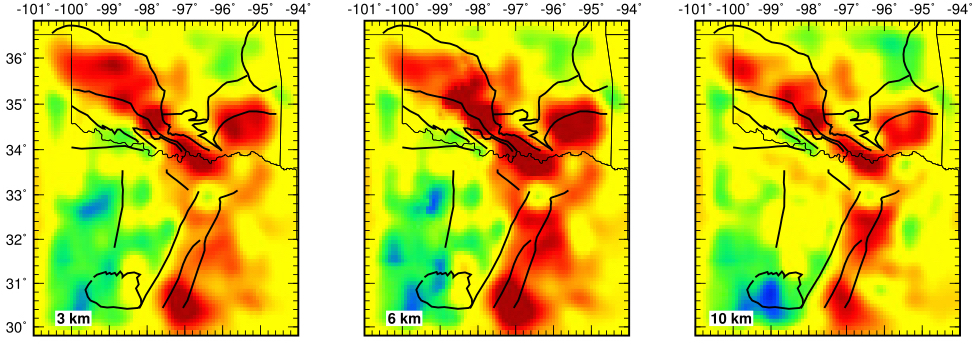
Key publications related to this direction:
(1) H. Zhu, 2018, Crustal wavespeed structure of the North Texas and Oklahoma based on adjoint noise cross-correlation functions and adjoint tomography, Geophysical Journal International, 214, 716–730.
1.4 Partial Melting Underneath Mid-Ocean Ridges
As the oceanic plates separate at Mid-Ocean Ridge Spreading Centers, partial melting of the upwelling mantle creates magma to form a layer of basaltic crust with thickness around 6 to 7 km. Investigating the distributions of partial melting and temperature structure underneath the Mid- Ocean Ridges is important to understand melt delivery from the mantle, the eruption history along the ridge crest, and the process of crustal accretion. Most previous investigations relied on seismic velocities, however, there are large ambiguities for assigning velocities to physical properties, such as temperature, water content, partial melt or composition. One way to address this non-uniqueness problem is to include additional seismic attributes. Compared to seismic velocities, attenuation might be a better proxy for delineating the distribution of partial melting. The UTD Seismic Imaging Laboratory has successfully developed a Q-FWI platform, which allows us to simultaneously constrain velocity and quality factor Q distributions within the crust. We applied this approach to 2-D active source data acquired for the Axial Seamount. Our model reveals a layer around 0.5–1 km thickness with strong attenuation (Q around 50) beneath the sea floor, which might be indicative of fractured sediments. In addition, the magma chamber underneath the ridge axis is characterized with strong reductions in both velocity and quality factor. These results enable us to better investigate thermal structure and partial melting underneath this divergent plate boundary.

2. Earthquake Seismology
2.1 Earthquake rupture processes
Imaging earthquake rupture processes enables us to better understand the physics of fault failure/friction, and also allows us to estimate potential disasters and guide a rapid rescue response. Using the concept of time-reversal imaging, seismologists have used back projection analysis for locating earthquake sources and examining complex rupture propagations. This approach requires minimal a priori constraints and can be implemented by assigning summed data to each grid point according to the traveltimes of different seismic phases. The simplicity and robustness of the back projection analysis make it popular in many earthquake studies. Previous back projection studies have been commonly applied to teleseismic data from one or a few dense receiver arrays. Taking advantage of the well-sampled dense spatial coverage of local seismic networks deployed in Southern California, we developed a novel multi-azimuth back projection approach and applied it to the 2019 Ridgecrest earthquake sequence to image its coseismic rupture processes. The geometric mean imaging condition is incorporated to suppress illumination artifacts caused by uneven station distributions and to improve spatial resolution. A 3-D crustal velocity model for Southern California and a fast marching solver are used to compute first-arrival traveltimes, which automatically accounts for lateral velocity heterogeneities within the crust, and does not require any empirical traveltime calibrations as used in classical teleseismic back projection. The stacked back projection images for the Mw 6.4 and Mw 7.1 events agree with the fault geometry determined by aftershocks. The Mw 7.1 Ridgecrest earthquake involves a bi-lateral rupture pattern along the fault plane. This approach allows us to better constrain detailed coseismic rupture processes for intermediate-size earthquakes using dense regional arrays and 3-D crustal velocity models.
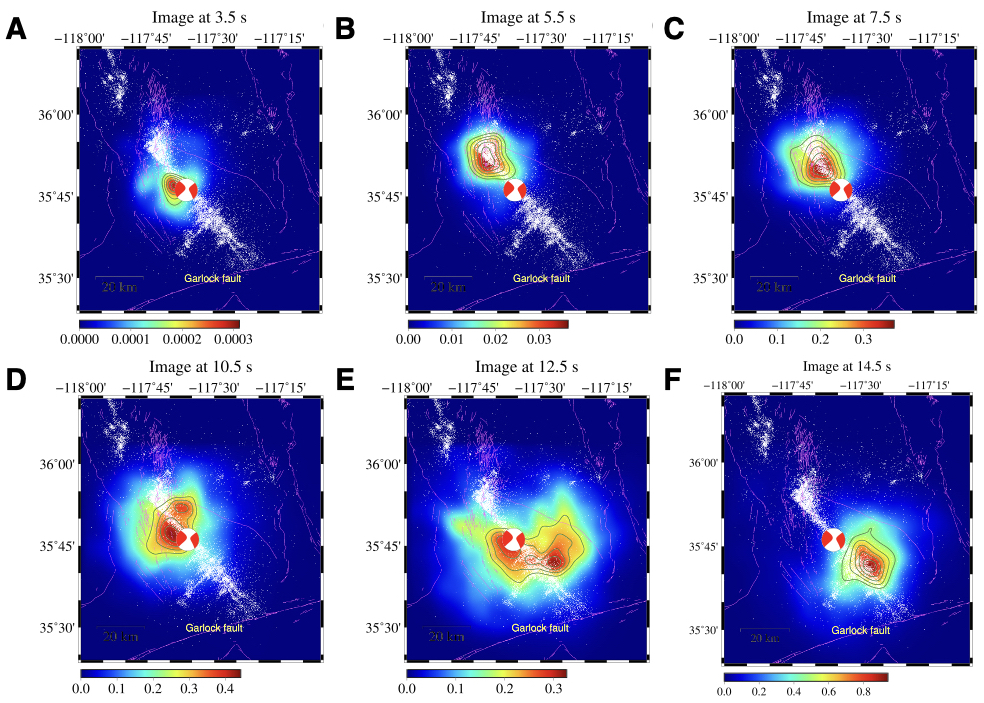
Key publications related to this direction:
(1) J. Yang and H. Zhu, 2019, Locating and monitoring microseismicity, hydraulic fracture and earthquake rupture using elastic time-reversal imaging, Geophysical Journal International, 216, 726–744.
(2) J. Yang, H. Zhu and D. Lumley, 2020, Time-lapse imaging of coseismic ruptures for the 2019 Ridgecrest earthquakes using multiazimuth backprojection with regional seismic data and a 3-D crustal velocity model, Geophysical Research Letters, e2020GL087181.
2.2 Induced Seismicity in Oklahoma
Over the past decade, seismologists have observed a significant increase in seismicity in the state of Oklahoma. Based on seismic observations and other geophysical/industrial measurements, some studies suggested possible links between the increasing seismicity with the disposal of wastewater and hydraulic fracturing during unconventional oil and gas production. To better monitor seismic events and investigate their faulting/triggering mechanisms, we need accurate earthquake source parameters, such as earthquake location, initial times and moment tensor solutions. To date, most of these parameters are estimated based on 1-D crustal velocity profiles. In this study, we use the high-resolution, 3-D crustal velocity model that we developed for the state of Oklahoma to better locate earthquakes and constrain their faulting mechanisms. We compare the locations of earthquakes occurred from 2011 to 2018 in central Oklahoma, determined by using both 1-D and 3-D crustal velocity models. The new locations allow us to better delineate the trajectory of faults in the study region, such as the branch of the Wilzetta fault hosting the 2011 Prague sequence. In addition, the depths of these new locations are systematically shallower than those listed in the IRIS catalog, which was derived from a 1-D velocity profile. Such observations will have important implications for us to investigate the relations between industry activities and induced earthquakes, such as the spatial/temporal migration of earthquakes with the injection volume/rate of wastewater. They are also helpful for us to better evaluate subsurface hydro-geology conditions.

Key publications related to this direction:
(1) S. Zhang and H. Zhu, 2020, Building a new catalog for induced earthquakes in Oklahoma based on a 3-D velocity model, submitted to Seismological Research Letters.
3. Exploration Seismology
3.1 Full waveform inversion
Over the past decade, FWI has become an important model building technique in both global and exploration seismology. Although it has been successfully applied to many synthetic and field data experiments, there are still many theoretical and practical challenges for this technique, such as how to deal with cycle-skipping, to quantify uncertainties, to mitigate tradeoffs in multi-parameter inversion, and to add regularization, etc. Among these difficulties, the cycle-skipping problem probably is one of the most significant challenges because it directly determines whether FWI can converge toward a correct solution or not. One way to tackle this challenge is to design well-behaved misfit functions for this nonlinear inverse problem, which allow us to avoid local minima. The UTD Seismic Imaging Laboratory has developed two new misfit functions which have better properties in comparison with classical least-squares waveform differences. They are based on adaptive matching filter and local time warping. Both of them enable us to better quantify time-varying traveltime differences between two seismic signals. Numerical experiments based on these new misfit functions have demonstrated their capability to mitigate the cycle-skipping problem. In addition, the UTD Seismic Imaging Laboratory has also been working on other issues related to FWI, including quantifying uncertainty associated with FWI solutions, incorporating sparsity regularization in FWI, analyzing the properties of the Hessian and its applications in multi-parameter inversion, etc. These developments enable us to fully utilize FWI to construct high-resolution subsurface models, which will improve the success rate of exploration projects.

Key publications related to this direction:
(1) H. Zhu and S. Fomel, 2016, Building good starting model for full waveform inversion based on adaptive matching
(2) H. Zhu, S. Li, S. Fomel, G. Stadler and O. Ghattas, 2016, A Bayesian approach to estimate uncertainty for full-waveform inversion using a prior information from depth migration, Geophysics, 817, R307–R323.
(3) Z. Xue, H. Zhu and S. Fomel, 2017, Full waveform inversion using seislet regularization, Geophysics, 82, A43–A49.
(4) H. Zhu, 2018, Seismogram registration via Markov chain Monte Carlo optimization and its applications in full waveform inversion, Geophysical Journal International, 212, 976–987.
3.2 Reverse time migration
Reverse time migration (RTM) is a powerful imaging technique for mapping the locations and amplitudes of reflectors in the subsurface. To achieve better image quality, we design algorithms to honor the physics of wave propagation in the subsurface. Over the past five years, the UTD Seismic Imaging Laboratory has developed several techniques, which allow us to consider elasticity, anisotropy and attenuation in the applications of RTM. In elastic RTM, wave mode decomposition is a crucial step for accurately extracting PP- and PS- reflectivity, which enable us to better interpret imaging results, detect fluids and locate reservoirs. Conventionally used divergence and curl operators in elastic RTM change the amplitudes, units, and phases of the extrapolated wavefields, resulting in noisy and inaccurate PS images. We have developed a new technique to better separate P- and S-waves in elastic media using the Helmholtz decomposition. The decomposed wavefields based on this new approach have the same amplitudes, units, and phases as the extrapolated wavefields. Since the decomposed P- and S-waves are vector fields, we proposed a new vector imaging condition to construct PP-, PS-, SS-, and SP-images. Elastic RTM images based on the vector imaging condition have higher quality and avoid the well-known polarity reversal problem in comparison with images based on the divergence and curl separation or direct component-by-component cross-correlation.

Key publications related to this direction:
(1) H. Zhu, 2017, Elastic wavefield separation based on the Helmholtz decomposition, Geophysics, 82, S173–S183.
(2) J. Yang, H. Zhu, W. Wang, Y. Zhao and H. Zhang, 2018, Isotropic elastic reverse-time migration using the phase- and amplitude-corrected vector P- and S-wavefields, Geophysics, 83, S489–S503.
(3) J. Yang and H. Zhu, 2018, Viscoacoustic reverse-time migration using a time-domain complex-valued wave equation, Geophysics, 83, S505-S519.
(4) J. Yang, H. Zhang, Y. Zhao and H. Zhu, 2019, Elastic wavefield separation in anisotropic media based on eigenform analysis and its application in reverse-time migration, Geophysical Journal International, 217, 1290–1313.
(5) J. Yang and H. Zhu, 2019, Viscoacoustic least-squares reverse time migration using a time-domain complex-valued wave equation, Geophysics, 84, S479–S499.
3.3 Forward Modeling
Seismic forward modeling is the foundation for imaging and inversion. In order to obtain good migration images and velocity models, we need the forward modeling engines to honor the physical realities in the subsurface.It is well known that materials in the Earth’s subsurface exhibit attenuation and anisotropy. Without properly taking these viscous and anisotropic effects into account, we will get inaccurate results in seismic modeling, migration and inversion, which will lead to wrong geological interpretation and reservoir characterization. The UTD Seismic Imaging Laboratory has developed several forward modeling engines to better simulate seismic wave propagation in viscoacoustic and anisotropic media. These developed algorithms help us to better image reflectivity and velocity distributions in complicated subsurface environments. For instance, the developed viscoacoustic wave equation allows us to: (1) separate physical dispersion and amplitude dissipation, which can be utilized in Q-compensated RTM; (2) explicitly incorporate Q in the wave equation, which can be utilized in Q-FWI. In comparison to other viscoacoustic wave equations, our new time-domain wave equation can be efficiently solved by using conventional finite difference and fast Fourier transform. In addition, the developed anisotropic wave equation allows us to avoid S wave artifacts and capture accurate P wave kinematics in VTI and TTI media. This new pure quasi-P wave equation involves a modified acoustic wave equation and a Poisson’s equation, which can be efficiently solved in comparison to other available anisotropic wave equation solvers.
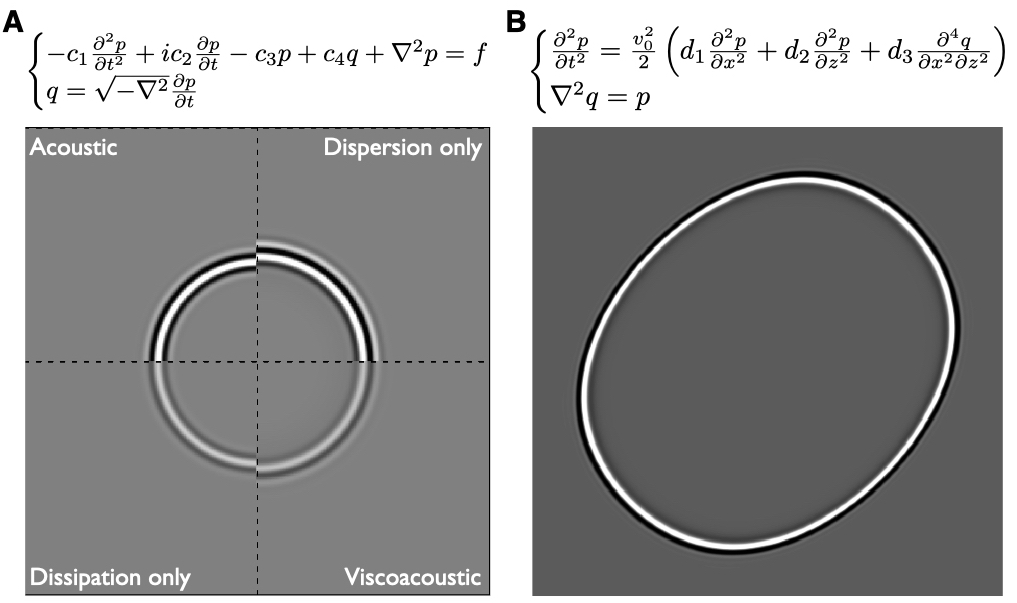
Key publications related to this direction:
(1) J. Yang and H. Zhu, 2018, A time-domain complex-valued wave equation for modeling viscoacoustic wave propaga- tion, Geophysical Journal International, 215, 1064–1079.
(2) X. Li and H. Zhu, 2018, A finite-difference approach for solving pure quasi-P wave equations in transversely isotropic and orthorhombic media, Geophysics, 83, C161–C172.
